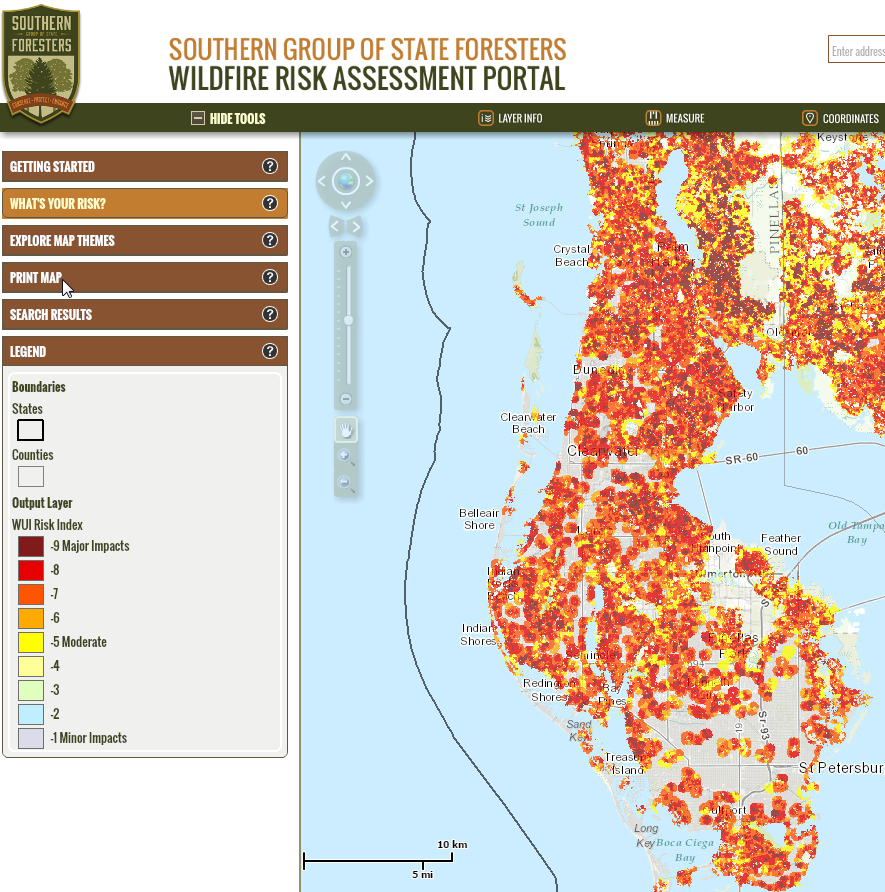It is no secret that government agencies love their acronyms and there is no exception here. Today, I will be talking about the Wildland Urban Interface (WUI), or what some refer to as the “Woo-Eee”. If you break this term up, you may be able to come up with a pretty good idea of what the WUI is all about. Let’s start with the word “interface” first. Interface can be defined as a point where two systems, subjects, organizations, etc., meet and interact. With that, we can probably conclude that the wildland urban interface is the point where wildlands or natural areas meet and interact with urban or developed areas.
So what’s the big deal? Well, there is a lot to consider with WUIs depending on your role in or around them. Are you managing WUIs, living within a WUI, studying WUIs, etc.? I think it would be safe to say that for the majority of you reading this article in Pinellas County, (the most densely populated county in the state) you are living within a WUI.

Pinellas County saw an explosion of development throughout the later 1900s and as a result, the existing natural lands that existed were replaced with residential and commercial developments. As these natural lands were fragmented into smaller and smaller pieces of land, the amount of available wildlife habitat decreased. Furthermore, as these undeveloped lands were utilized, associated changes in air, water, soil quality occurred. People and materials coming in from around the world to construct suitable homes can also result in the introduction of non-native and potentially invasive species including plants, animals and diseases. All of these transformations can impact our daily lives whether we realize these shifts are a result of the WUI or not.
As wildlife habitat becomes few and far between, native plant and animal populations either decrease or learn to adapt and survive in a more urban setting. Take the coyote for example; they have made their way to Florida from the west and are now documented in every county in Florida. As animals adapt to survive in developed landscapes, it is only a matter of time before we encounter them in our own yards and communities. Some of these encounters are exciting, but others…not so much. We could debate who was here first, but the reality is that we must learn to live with all wildlife. Of course, there are times when action will need to be taken with nuisance animals, ones that cause (or are about to cause) property damage, presents a threat to public safety, or cause an annoyance within, under or upon a building. There are resources available to help us deal with these cases:
- Managing Nuisance Wildlife in Your Yard series – https://edis.ifas.ufl.edu/topic_series_managing_nuisance_wildlife_in_your_yard
- Dealing with Unwanted Wildlife in an Urban Environment – https://edis.ifas.ufl.edu/uw070

There are many issues associated with WUIs from managing wildfires to complications with land use policies, but one of the other WUI issues I mentioned earlier is the threat of invasive species. Invasive species are not only a threat to our native species, but can also be a nightmare for homeowners, property managers and land managers. There is a significant amount of time and money spent on invasive species control both on public and private lands. One thing we must keep in mind is that even if we have an invasive species in our yard that we want to keep, these plants and animals can easily spread to our natural lands (parks and preserves) and threaten the native ecosystems there. It is important to remove invasive species from your yard as soon as they are identified. Below are some resources to help you identify non-native, invasive species in our area:
- UF/IFAS Assessment of Non-Native Plants in Florida’s Natural Areas – http://assessment.ifas.ufl.edu/
- Florida Exotic Pest Plant Council – http://fleppc.org/
- Florida Invasive Species Partnership – http://floridainvasives.org/
As we continue to live in the WUI world, we also need to keep an eye on our natural resources that may be impacted. We all depend on natural resources to live our everyday lives and in a very developed county like Pinellas it is important that we don’t lose touch with the natural areas that once covered these lands.
For resources specific to Pinellas County, please visit: http://pinellas.ifas.ufl.edu/natural-resources.shtml
Sources:
Wildland Urban Interface: Varied Definitions – https://edis.ifas.ufl.edu/fr287
Wildland Urban Interface: Key Issues – http://edis.ifas.ufl.edu/fr264
 0
0
